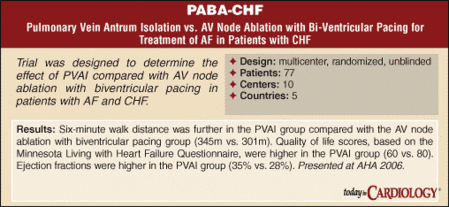Most patients with AF benefitted from pulmonary vein antrum isolation
Ejection fraction and six-minute walk test improved in PABA-CHF trial.
CHICAGO — About 74% of patients with congestive heart failure experienced quality of life and ejection fraction improvement after pulmonary vein antrum isolation treatment, according to Andrea Natale, MD, head of the section of electrophysiology and pacing at the Cleveland Clinic.
Atrioventricular (AV) node ablation with biventricular pacing is not a cure for atrial fibrillation, but the goal of pulmonary vein antrum isolation (PVAI) is to directly eliminate AF, according to Natale.
Natale presented data from the Pulmonary Vein Antrum Isolation vs. AV Node Ablation with Bi-Ventricular Pacing for Treatment of AF in Patients with Congestive HF (PABA-CHF) trial at the American Heart Association Scientific Sessions 2006.
PVAI improved AF
Researchers randomized 39 patients to receive PVAI and 38 to receive AV node ablation with biventricular pacing. The patients had refractory AF and an EF of no more than 40%. All patients received optimal medication therapy, including ACE inhibitors and beta-blockers.
Researchers performed follow-up at three and six months. All primary endpoints were met, which included a six-minute walk test, the Minnesota Living with HF Questionnaire and EF on echocardiography, according to Natale.
The six-minute walk distance in the PVAI group was 345 m, compared with 301 m in the control group (P=.0001). Patients in the PVAI group experienced improvements in quality of life scores compared with the AV node ablation group (60 vs. 80, P<.0001). The researchers also found a higher EF in the PVAI group (35% vs. 28%, P=.0004).
“Ejection fraction improved in patients in the [PVAI] arm of the study,” Natale said.
The researchers also conducted a subanalysis of patients by AF categories, which included paroxysmal AF, persistent AF and permanent AF. Among patients who received AV node ablation, 42% experienced worse AF severity. However, 94% of patients in the PVAI group were able to move to a better category, compared with 4% in the other group.
Researchers also found remarkable shrinking of the left atrial in the PVAI group compared with an increase in the AV node ablation group, Natale said. At baseline, the left atrial in the PVAI group was about 4.8 cm compared with about 4.6 cm in the AV node ablation group. At six months, the PVAI group decreased in size to about 4.4 cm compared with a growth in the other group to about 4.8 cm (P=.0005).
The trial presented a good success rate for PVAI with few complications, said discussant Alan Kadish, MD, a professor in the division of cardiology at Northwestern University Medical School, Chicago. However, the study was limited because it was not blinded, according to Kadish. In addition, follow-up time was limited.
Kadish compared the PABA-CHF results to the results of the Atrial Fibrillation Follow Up Investigation of Rhythm Management (AFFIRM) trial in which rate and rhythm control were compared in patients who did not have CHF. The trial found that rate and control was at least as good as rhythm control.
The AFFIRM trial findings were different from PABA-CHF; AFFIRM researchers found rate control was better than rhythm control. Differences in findings could be attributed to differences in study designs. Kadish also said that rhythm control techniques have improved.
“Despite the small number of patients and limitations, data of PABA-CHF are compelling,” and PVAI could be a reasonable – and perhaps preferable – method to AV node ablation, he said. – by Lauren Riley

For more information:
- Natale A. Results of a randomized controlled trial of Pulmonary Vein Antrum Isolation vs. AV Node Ablation with Bi-Ventricular Pacing for Treatment of Atrial Fibrillation in Patients with Congestive Heart Failure (PABA-CHF). Presented at: American Heart Association Scientific Sessions 2006; Nov. 12-16, 2006; Chicago.
